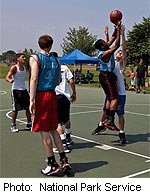
MONDAY, Sept 13 (HealthDay News) — Children’s basketball may be getting rougher or the kids may be bigger, but either way the number of head injuries is soaring, researchers report.
“Although the total number of injuries decreased during the study period, the number of traumatic brain injuries increased by 70 percent,” said study author Lara McKenzie, of the Center for Injury Research and Policy at Nationwide Children’s Hospital in Columbus, Ohio.
“These injuries are exceedingly high in this popular sport,” she added. “This is cause for alarm.”
McKenzie thinks the increased size of players is one factor in the increase in concussions. Another is that the game has become more competitive, she said.
Why total injuries have gone down by 20 percent over the 11 years covered by the study is not clear, McKenzie added.
“We don’t want to discourage kids from physical activity. We don’t want to discourage kids from playing basketball, either,” she said. “But we need to recognize that there are some inherent risks in any activity.”
McKenzie added that the problem of traumatic brain injury needs to be addressed. “Maybe we need to do more education of coaches, athletes and parents to recognize the signs of concussion and help to prevent them,” she said
The findings are published in the Sept. 13 online edition of the journal Pediatrics.
For the study, McKenzie’s team used data from 1997 to 2007 from the U.S. Consumer Product Safety Commission’s National Electronic Injury Surveillance System to estimate the number of children injured while playing basketball. Over the study period, the researchers found an estimated 4,128,852 children were treated in emergency rooms for injuries sustained while playing the sport. That’s 375,350 every year.
While the total number of injuries went down over the study period, traumatic brain injuries increased 70 percent, the researchers found.
The most common other injuries were sprains in the legs — 30.3 percent, particularly of the ankle (23.8 percent).
Boys were more likely to suffer cuts, fractures and dislocations, while girls were more likely to suffer concussions and knee injuries. Children 15 to 19 years of age were three times more likely to injure their knees and ankles, while younger children, aged 5 to 10, were more likely to suffer concussions, fractures and dislocations, the study found.
McKenzie noted that concussions in children can have significant and lasting effects. “It can affect their health, memory, their learning — ultimately their survival,” she said.
The problem of concussions is one that is plaguing all children’s team sports, McKenzie said. But, she added, the increase may not be an actual increase, but rather better recognition of the problem and more awareness of the signs and symptoms of concussion.
Dr. Lyle Micheli, head of the sports medicine division at Children’s Hospital Boston and an associate professor of orthopedics at Harvard Medical School, said the study findings were “no surprise.”
Micheli agreed that children’s sports are being played more aggressively, which is one factor in the rise in the number of injuries, particularly concussions. “If you did the same study for soccer I think you would see even more of a trend,” he said.
Children are also playing more sports in school and after school in sports leagues, which boosts the chances for injury, Micheli said. “Parents have to be thoughtful about their objectives for their kids in sports. Are they looking for healthful exercise? Are they looking for an activity that can give them friendships? But how much is enough and how much is too much? That’s the real challenge for every family,” he said.
When sports starts to rule kids’ lives, that can strain a child’s physical well-being, Micheli said. “We are certainly seeing a lot more overuse injuries in kids,” he said.
More information
For more on concussions, visit the U.S. Centers for Disease Control and Prevention.

